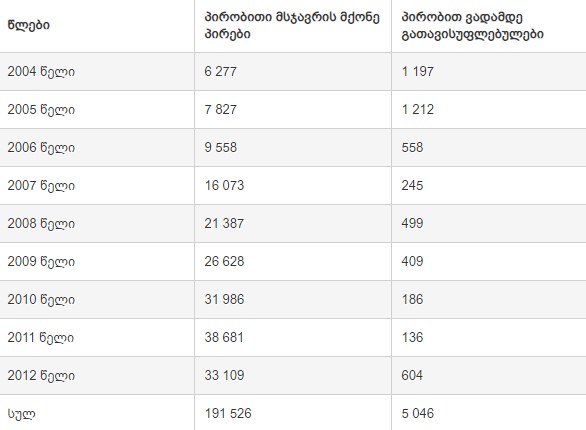Dimitri Lortkipanidze, Director of the Primakov Georgian-Russian Public Centre, was a guest on Alt-Info’s Dghis Komentari at 12:30 programme where he discussed the statistics of criminal cases under UNM rule.
Dimitri Lortkipanidze named London College’s 2011 International Survey as a source of his statistics and voiced a number of critical claims based on this survey.
Most likely, Mr Lortkipanidze was referring to King’s College London’s survey which was also featured in Georgian journalist Tea Topuria’s article published in 2011 on the Institute for War and Peace Reporting’s website (King’s College London - World Prison Population List). When looking for the initial source of the article, FactCheck found the International Centre for Prison Studies survey which studied the number of prisoners across 218 sovereign countries per 100,000 people in 2008-2011.
FactCheck verified Dimitri Lortkipanidze’s statements based on all of the relevant sources.
Claim N1: Georgia was ranked 2nd in the world in terms of the number of prisoners.
Verdict: MOSTLY TRUE
Since 2003 when the United National Movement came to power, the number of prisoners has been growing. This growth became particularly notable from 2006 which was perhaps associated with the reforms carried out in the system and the introduction of a “zero tolerance” policy. The number of prisoners peaked in 2011 (24,114 prisoners).
According to the World Prison Population List, compiled by the International Centre for Prison Studies (ICPS), Georgia was ranked 4th in terms of the number of prisoners and was “outperformed” by the USA, Rwanda and Russia alone. However, according to the article published on the IWPR’s website which also reviewed the World Prison Population List produced by King’s College London, Georgia is ranked 6th among 17 countries with 538 prisoners per 100,000 people.
Although Dimitri Lortkipanidze’s statistics are not in line with either the ICPS’s or the IWPR’s figures, each of these surveys prove that Georgia had one of the largest prisoners to the population ratio in 2011. Therefore, FactCheck concludes that this statement is MOSTLY TRUE.
Claim N2: Every third Georgian had a criminal record.
Verdict: MOSTLY FALSE
As part of one if its articles, FactCheck requested statistics of criminal cases considered by Georgian courts in 2004-2013 from the Supreme Court of Georgia. According to the information it provided, Georgia’s first instance courts considered 122,557 criminal cases in total against 148,682 individuals over the course of nine years.

Some of these cases were either sent back to the Prosecutor’s Office, criminal proceedings were suspended or convicts were sentenced to mandatory medical treatment. For the rest of the cases, court judgments were made either through plea bargains or after substantive consideration.
As of 1 January 2011, Georgia’s population was nearly four million. If we subtract the number of people to whom the measures of Criminal Code were not applicable because of their juvenile age from that four million, the proper number to verify Dimitri Lortkipanidze’s statement will be 3.725 million. A third of 3.725 million is almost ten times higher as compared to the figure provided by Mr Lortkipanidze. Therefore, his claim is technically inaccurate and FactCheck concludes that the statement is MOSTLY FALSE.
Claim N3: The number of probationers was several hundred thousand.
Verdict: FALSE
As part of one its articles, FactCheck verified Bidzina Ivanishvili’s statement where he claimed that “there were 300,000 probationers under UNM rule in Georgia.” The National Probation Agency provided FactCheck with statistics of probationers in 2004-2012.
A probationer is not a legal term since we cannot find the definition of a probationer in any law or subordinate normative act. According to the National Probation Agency, this term is often used to describe people with non-custodial punishment or those who were conditionally released before serving their full jail term.

These statistics provided by the National Probation Agency are not entirely accurate. The Agency explained that these statistics may include individuals as probationers who were considered probationers in previous years as well. Nevertheless, FactCheck still summarised the information received from the National Probation Agency. In this case, there were 191,526 people with conditional sentences and additional 5,046 conditionally released before the due date. This makes a tally of probationers at 196,572 at most.
However, as mentioned earlier, this figure is also an exaggeration as compared to reality because some individuals who were probationers for several years repeatedly end up in the statistics of different years. For instance, if a person was conditionally sentenced to five years in 2005, he is included in the statistics of 2005, 2006, 2007, 2008 and 2009 as well. Therefore, there is no information about a real figure in Dimitri Lortkipanidze’s statement. The only relevant and available statistics illustrate that it is virtually impossible for the number of probationers to be above 200,000. Therefore, given the lack of factual ground when making this statement, FactCheck concludes that Dimitri Lortkipanidze’s statement is FALSE.
Claim N4: Acquittal judgements were never rendered at all and the statistics showing 0,00018% of acquittals prove this.
Verdict: TRUE
It is often argued that the growth of acquittal judgements is proof of court independence: “Although the number of acquittal/guilty judgements taken separately is insufficient and an unreliable indicator to assess the judiciary system, the statistics of extremely low acquittal judgements, simultaneously with other challenges that the system continues to face, by itself shows an authentic picture of the judiciary.” [1]
As a part of one of its articles, FactCheck requested information from the Supreme Court about judgements in 2004-2013 in order to identify the relevant trends.
According to this information, the court rendered guilty judgements to 64,140 people (out of 64,537) of the total cases under substantive consideration over the course of nine years. The average percentage figure of guilty judgements for the nine years is 99% which is also indicative of serious challenges facing the judiciary. The number of prisoners and the inmate mortality rate was also rather high in this period and FactCheck has written about these issues in the past.
Given all of the aforementioned and despite the fact that Dimitri Lortkipanidze’s figure is technically inaccurate, the fact that only 397 people out of 64,357 involved in criminal proceedings were acquitted over a nine-year period leads FactCheck to conclude that Mr Lortkipanidze’s statement is TRUE.
[1] Social Justice Centre: How Judicial Independence Degree is Measured – Statistics of Acquittals
Editor’s Note
FactCheck made several changes to this article after its publication. In particular, Dimitri Lortkipanidze’s claim in the initial version about the prison population was verified based only on the article published on the Institute for War and Peace Reporting’s website. However, in the updated version, Mr Lortkipanidze’s figures were also verified vis-à-vis the International Centre for Prison Studies survey because this is the only primary source which studied prison population in 2008-2011.
Since there is only a slight difference between the figures given in the article published on the Institute of War and Peace Reporting’s website and those provided in the International Centre for Prison Studies survey, the additional use of the ICPS’s source has not affected the verdict.







